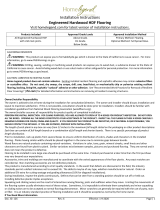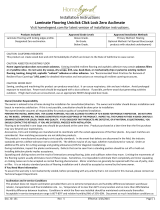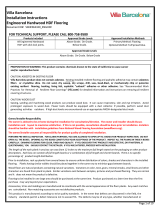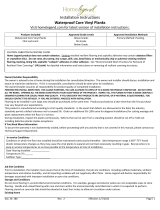
For Assistance, Call: 1-800-986-3460
HomeDepot.com/homedecorators
Installation Instructions
Laminate Flooring (For Indoor Use Only)
Grade Levels
Above Grade
On Grade
Below Grade
CAUTION: Use safety glasses and gloves when cutting this product. During
the cutting process, laminate may create wood dust; be sure to install in a
well-ventilated area.
OWNER/INSTALLER RESPONSIBILITY
The owner is advised to be at home during the installation for consultation/
direction. The owner and installer should discuss installation and layout to
maximize satisfaction. If this is not possible, consultation should be done prior to
installation. Installers should be familiar with installation guidelines from North
American Laminate Floor Association (nalfa.com). The owner/installer assumes
all responsibility for product quality of completed installation.
PERFORM PRE-INSTALL INSPECTION. FOR CLAIMS PURPOSES, YOU ARE ALLOWED
TO OPEN UP TO 4 BOXES FOR PRODUCT INSPECTION. DO NOT OPEN ALL THE
BOXES. OPENING ALL THE BOXES CONSTITUTES YOUR ACCEPTANCE OF THE
PRODUCT. INSPECT ALL THE PLANKS IN THESE 4 BOXES CAREFULLY. EXAMINE
FLOORING FOR COLOR, FINISH AND QUALITY. IF YOU DISCOVER THAT PRODUCTS
ARE DEFECTIVE, OR IF MATERIAL IS QUESTIONABLE, YOU SHOULD CONTACT THE
RETAILER. IF YOU ARE SATISFIED, PROCEED WITH INSTALLATION.
Prior to installation, rack up planks from several boxes to ensure uniform
distribution of colors, shades and characters in the installed ooring.
Purchase ooring to be installed in one large area at the same time. Product
purchased at a later time than the rst purchase may vary beyond your
expectations.
Accessories, trims and moldings are manufactured to coordinate with the varied
appearances of the oor planks. Any exact matches are coincidental. Non-
matching accessories are not defective products.
This product is manufactured according to strict quality standards. In the event
that defects are discovered in the eld, the industry standards permit a defect
tolerance not to exceed 5%. An additional 5% (10% for diagonal installations)
should be factored in for cutting wastage and grading allowances.
During installation, inspect the planks continuously. Defects that can be seen
from a standing position should be cut off or held out. Installing defective planks
implies acceptance.
Squeaking and clicking noises are the result of interactions among ooring, joists
and suboors when they move. Limiting the movements of the ooring system
usually eliminates most of these noises. Sometimes, it is impossible to eliminate
them completely and minor squeaking or clicking noises are to be accepted as
normal ooring phenomenon.
Minor scratches can generally be repaired with the use of putty, stain or ller. It
is an industry standard practice of ooring installation and it should be accepted
as normal by the home owner.
To assure the warranty is not inadvertently voided, before proceeding with any
activity that is not covered in this manual, please contact our Customer Support
Team at 800-986-3460.
ACCLIMATION AND IN-SERVICE CONDITIONS
Acclimation is the process of adjusting (conditioning) the moisture content of
laminate ooring to the environment in which it is expected to perform. The
laminate ooring is fully acclimated when its moisture content and dimensions
(width and length) are stable. For example, the averaged dimensions and
moisture content remain constant for 2 consecutive days. Flooring must
acclimate for as long as necessary to reach fully acclimated stage. Acclimation
time varies depending on geographical area, interior climate control and time of
the year. Minimum acclimation time is 48 hours.
Elevate cartons from the oor by placing them on 2x2 in. lumber or equivalent.
Place spacers (3/4 in. to 1 in. sticks) between each layer or cross stack the
layers for maximum exposure to ambient conditions. Acclimation temperature
range is 60°F-80°F and relative humidity (RH) of 35%-60%. Conditions in which
the oor was acclimated should be maintained continuously thereafter.
CONCRETE SUBFLOOR REQUIREMENTS
Concrete suboors must:
Have minimum rated strength of 3000 psi.
Be level to within 1/8 in. in a 6 ft. span or 3/16 in. in a 10 ft. span; no bumps or
low spots. High spots can be removed by grinding; depressions can be lled with
patching compound formulated for use in oor installation.
Be clean; no construction debris, soil, mud and any other objects on or adhering
to the oor; if necessary, scrape and sweep away before the installation; no
protrusions of nails, debris, metals should remain.
New concrete slab must cure for at least 90 days. It must have a minimum 10 mil
polyethylene sheet between the ground and the concrete.
Be free from moisture related conditions which can damage the installed
ooring.
CONCRETE MOISTURE
Test all concrete suboors for moisture content and document the results. Visual
checks are not reliable.
Perform tests at locations around exterior doorways, near walls containing
plumbing, near foundation walls and in the center of the room. Minimum sample
size is 3 samples per 1000 sq. ft. of area and one test for every additional 1000
sq. ft. thereafter.
Moisture content should meet one of the following criteria:
Less than 5% when tested using Tramex Concrete Moisture Encounter.
Less than 316 pounds per 1000 sq. ft. per 24 hours when using Calcium Chloride
test (ASTM F-1869).
Less than 2.5% when using Calcium Carbide (CM) test (ASTM D-4944-04
monied).
NOTE: Concrete moisture content may be acceptable the time of the test.
These tests do not guarantee a perpetual “dry” concrete slab. The concrete slab
moisture content can vary at other times of the year. We are not responsible for
moisture-related damage to installed ooring.
LIGHT WEIGHT CONCRETE
Light weight concrete is concrete with a rated strength that is less than 3000
psi. Perform a quick check by drawing a nail across the top; if it leaves an
indentation, it is probably light concrete.
WOOD SUBFLOOR REQUIREMENTS
The suboor must be clean; no presence of construction debris, soil, mud and
any other objects on or adhering to the oor; no protrusions of nails, debris, or
metals should remain. If necessary, scrape and sweep the suboor before the
installation.
The suboor must be structurally sound and stable; no movements or squeaks;
no loose panels or loose nails; no signs of ply de-lamination or other damages.
Repair all shortcomings before installation.
The suboor must be at; no visible bumps or low spots; the suboor should
be at to within 1/8 in. in 6 ft. span or 3/16 in. in 10 ft. Test for moisture using
a reliable moisture meter. Perform tests at locations around exterior doorways,
near foundation walls, near walls containing plumbing lines and in the center of
the room. Measure 20 locations per 1000 sq. ft. Moisture content of the suboor
should be less than 14%. Moisture content difference between the suboor and
ooring should be 2% or less.
1
Pre-Installation

For Assistance, Call: 1-800-986-3460
HomeDepot.com/homedecorators
Installation Instructions
Laminate Flooring (For Indoor Use Only)
Grade Levels
Above Grade
On Grade
Below Grade
PLYWOOD OR ORIENTED STRAND BOARD (OSB) SPECIFICATIONS
On truss/joist spacing of 16 in. (406 mm) O/C or less, the industry standard for
single-panel subooring is a minimum 5/8 in. (19/32 in., 15.1 mm) CD Exposure
1 plywood suboor panels (CD Exposure 1) or 23/32 in. OSB Exposure 1 suboor
panels, 4 ft. x 8 ft. sheets. Expansion gap between panels should be 1/8 in. (3
mm). If panels are not tongued and grooved and there is not sufcient spacing
or is inadequate, cut in the required spacing with a circular saw. Do not cut in
expansion space on tongue and groove panels.
PARTICLE BOARD OR FIBER BOARD
Only for oating installation.
EXISTING FLOORS
Installation over an existing oor requires the installer to consider potential
issues related to moisture damage, adhesive failure and fastener failure.
Contact the adhesive and fastener manufacturers respectively for their specic
instructions, recommendations and requirements.
Acceptable oor coverings include: solid hardwood, vinyl composition tile,
linoleum, terrazzo, ceramic tile and other “moisture sealing oors.”
Unacceptable oor coverings include: carpet, needle punch felt, edge glued
linoleum and other “moisture absorbing ooring.”
JOB SITE CONDITION
Prior to installation, the installer must ensure that at the time of installation, the
job site conditions including suboor/substrate, ambient temperature and relative
humidity, and all impacting variables will not negatively affect the oor. The
manufacturer will decline responsibility for damages associated with improper
installation or poor site conditions.
STORAGE AND CONDITIONS
Do not store ooring in uncontrolled environmental conditions. For example,
garages and exterior patios are not acceptable areas to store ooring. Handle
and unload the laminate ooring with care and store within the environmentally
controlled site in which it is expected to perform. Flooring stored on a concrete
slab should be elevated at least 4 in. to allow air circulation under cartons.
EXISTING HOME
An existing home should have a consistent room temperature of 60°F-80°F and
relative humidity (RH) of 35%-70%. Continual deviation from these conditions
will affect the dimensions of ooring. When using a heater during winter months,
humidity may be much lower than the acceptable range. During the warmer
months, maintain humidity levels using an air conditioner, dehumidier, or by
turning on your heating system periodically.
NEW CONSTRUCTION OR REMODEL
All work involving water, such as pouring basement concrete oors, drywall
and plasterwork, plumbing, etc. must be completed well in advance of the
oor delivery. Ensure that the building is enclosed. Where building codes allow,
permanent heating and/or air conditioning systems should be operating at least
ve days preceding installation and should be maintained during and after
installation. If it is not possible for the permanent heating and/or air conditioning
system to be operating before, during and after installation, a temporary
heating and/or dehumidication system that simulates normal living (occupied)
conditions can enable the installation to proceed until the permanent heating
and/or air conditioning system is fully operational. Your job site should have a
consistent temperature of 60°F-80°F and relative humidity (RH) of 35%-70%
which should be maintained continuously thereafter.
BASEMENTS AND CRAWL SPACES
Concrete slab or ground must be dry. The ground in the crawl spaces must be completely
covered using 6 mil black polyethylene. Crawl space clearance between the earth and
underside of joists should be no less than 18 in. and the perimeter vent area should be
equal to 1.5% of the total square footage of the crawl space or as mandated by code.
RADIANT HEATED SUBFLOOR
This product can be installed over a radiant heated suboor if the heating
element is installed into wood or concrete suboor. Operating surface
temperature must be less than 84°F. Decrease temperature to 60°F for one
week before installation in increments of 10°F per hour. Increase temperature
gradually after installation in increments of 10°F per hour. Follow installation
instructions for wood or concrete as outlined above.
WET AREAS
Do not install in saunas, swimming pool areas and other similar extreme wet
areas. Fill all expansion gaps with water repellent sealant.
MOISTURE BARRIER AND MOISTURE RETARDER
CONCRETE SUBFLOOR
For oating installation, use 6 mil (0.006 in.) virgin polyethylene lm or other
means with equivalent permeability. Overlap the edge seams and tape it
together. Extend moisture barrier up to the wall about 1 in. high.
WOOD SUBFLOOR
Use asphalt-saturated kraft paper or #15 or #30 felt that meets ASTM Standard
D4869 or UU-B-790, Grade D. Overlap along the edge seams 2 in.- 4 in. wide.
This retards moisture movement from below. Extend the moisture retarder to
about 1 in. from the walls. Secure to the suboor as necessary.
SOUND CONTROL UNDERLAYMENT
Sound reducing underlayment is required. Check with the sound control
manufacturer for application guidelines. Generally, the less compressive
underlayment is preferred.
EXPANSION GAP
A 5/16 in. to 3/8 in. expansion gap is required around the perimeter of the oor
and between the oor and all vertical obstructions. Do not place permanently
mounted structures such as kitchen counters/cabinets on the installed oor.
TRANSITION MOLDING
Floating installation, transition T-molding is required in the following cases: oor
spanning greater than 30 ft. in length or width; wall openings with or without a
door.
NOTE: Floor areas interrupted by wall sections extending out of the wall;
oor areas which are not rectangular may experience buckling or gapping if
there is excessive oor expansion or shrinkage.
TOOLS AND MATERIALS BASICS
• Tape measure • Moisture meter (wood, concrete or both) • Chalk line & chalk
• Hammer • Electric power saw • Carbide tipped saw blade for ne cut
• NIOSH-designated dust mask • Hand saw or jamb saw • Eye protection
• Straight edge or Spacers • Pry Bar • Mallet • Broom • Tapping block
• Color matched wood putty • Pull bar • Sandpaper • Level • Duct tape
• Premium laminate glue • Vacuum • Caulking gun • Work gloves • Knee pads
Helpful Pointers
GENERAL TIPS
Remove all existing moldings.
Install ooring perpendicular to the direction of the oor joists.
If possible, install the boards parallel to the direction of the light
entering the room.
Make sure your work area is well lit. Good visibility ensures that color is
consistent and that visually defective planks are detected and removed.
The minimum length of the rst and last plank is 12 in.
Using a shorter piece at undercut door jams will help when tting
ooring in place.
2

For Assistance, Call: 1-800-986-3460
HomeDepot.com/homedecorators
Installation Instructions
Laminate Flooring (For Indoor Use Only)
Grade Levels
Above Grade
On Grade
Below Grade
CUTTING THE LAST ROW TO WIDTH
Most often the entire length of the last row will need to be cut so that it is
narrow enough to t the remaining space.
Measure the distance between the oor face edge (exclude the tongue) to the
wall. Subtract 5/16 in. from this measurement for expansion gap. Draw a line.
Cut through the line. Discard the excess piece. Proceed with the installation.
Preparing for Installation
Ensure suboors are clean.
Understand the locking part of the ooring plank. The tongue is the thinner
extension coming out of the side of the planks. The groove is the wider extension
coming out of the other side of the oor plank.
Groove / Rainure / Ranura
(Short side / Côté court / Deslizador corto)
Tongue
(Long side)
Languette
(Côté long)
Lengüeta
(Deslizador largo)
Groove
(Long side)
Rainure
(Côté long)
Ranura
(Deslizador largo)
(Short side / Côté court / Deslizador corto)
Tongue / Languette / Lengüeta
Lay out several cartons. Randomly rack planks to ensure good color and shade
mixture and end joint spacing. Minimum end stagger is 6 in. Inspect plank quality
and grading.
Lay out trim moldings in advance and nd planks whose shade closely matches.
Set these aside for future use.
Remove the existing base, shoe molding or threshold carefully. They can be used
to cover the 5/16 in. expansion gap left around the edge of the room. Undercut
doors and casings using a handsaw laid at on a piece of scrap ooring.
Install the underlayment according to the underlayment manufacturer instructions.
Install the underlayment in the same direction that the laminate ooring is
to be installed.
Tape all seams.
Stagger end joints but avoid stair-stepping appearance by varying stagger
distances between adjacent rows. Minimum stagger distance is 6 in.
Check door clearances, making necessary adjustments before laying the oor.
Floating Installation
1. INSTALLING THE FIRST ROW
a. When possible, begin installation from the straightest wall (Fig. 1A). If
possible, install the oor perpendicular to the oor joists (Fig. 1B).
b. Use a carbide-tipped circular saw blade to remove both the short and long
side tongues from the plank to allow room for spacers. Do not trim the
groove sides (Fig. 1C).
c. Trim the long side tongue from each plank needed to complete the rst
row. Install the planks from left to right. Place 3/8 in. spacers between the
wall and the cut edge of the planks to ensure a 3/8 in. space along the
perimeter (Fig. 1D).
d. Adjoin the planks by using a tapping block as shown (Fig. 1E) and gently
tap until the planks are joined. Continue this process until the nal plank
for the row is needed.
1C1B1A
1D
1E
2. COMPLETING A ROW
a. When cutting a plank used for completing a row be sure to allow for the
proper 3/8 in. gap once the plank is installed. (Fig. 2A)
b. Use a pull bar in place of a tapping block to close the gap between the two
planks to complete the row (Fig. 2B). If the remainder of the cut plank is a
minimum of 12 in. long it may be used to start the next row.
5/16” gap
2A 2B
3

For Assistance, Call: 1-800-986-3460
HomeDepot.com/homedecorators
Installation Instructions
Laminate Flooring (For Indoor Use Only)
Grade Levels
Above Grade
On Grade
Below Grade
3. INSTALLING THE SECOND AND REMAINING ROWS
a. Begin installing the second row by angling the plank to allow the tongue to
slip into the groove of the plank in row 1 (Plank C, Fig. 3A). Maintain inward
pressure (towards the previous row) while gently moving the plank up and
down as you slowly push the plank to the oor (Fig. 3B). Do not force the
plank to the oor if the tongue is only partially inserted into the groove.
b. Install the next plank by placing it near the previous plank in the row and
laying it at to the oor while leaving a small gap (2-3 mm) between the
short ends of planks D and C (Fig. 3C).
c. Once the plank is lying at, gently tap the plank as described at the end of
step 2 to join planks C and D (Fig. 3D).
d. Placing the tapping block no closer than 8 in. from either end, tap lightly
along the long side to ensure the joint is fully seated and no gaps exist. (Fig.
3D) Note: Uneven tapping or use of excessive force may damage the joint.
e. Continue laying the oor from left to right, as described in the previous steps
(Fig. 3E). Remove the short side tongue from any full planks used in starting
a new row.
f. Trim the planks to be used in the nal row to the desired width while taking
into consideration the necessary gap of 5/16 in. needed between the planks
and the wall. Install the nal row as described in the previous steps (Fig. 3F).
20º
20º
C
3A 3B
C
D
C
D
3C
3D 3E 3F
4. INSTALLING THE LAST ROW
Use the pull bar to draw the last row to t tightly to the previous row (Fig. 4A).
4A
USE PULL BAR LAST ROW
4. FINISHING THE INSTALLATION
Remove all spacers (Fig. 5A).
Create a watertight seal by rst lling the entire expansion perimeter,
T-molding spaces, and other open areas with 3/8 in compressible PE foam
backer rod (Fig. 5A).
Next cover the backer rod and any remaining gaps with 100% silicone sealant.
DO NOT use acrylic sealants.
Prior to installing the molding, apply silicone sealant to the portion of the
molding or transition that will contact directly with the laminate ooring
surface. Install moldings and immediately wipe away any excess silicone
sealant. Apply silicone sealant at connections to door frames, T-Joint
moldings, or any other xed objects.
Install moldings and immediately wipe away any excess silicone sealant.
5A
INSTALLING AROUND MOLDINGS AND DOOR JAMBS
In challenging areas such as door moldings where planks can’t be installed at
an angle it may be necessary to modify the joint. Begin by removing a portion of
the groove from the planks being tted to in the previous row by either planing
or sanding. Once the material is removed apply a small amount of laminate glue
to the top of the subsequent plank’s tongue and install it by sliding it on the oor
into place. Wipe up excess laminate glue with a damp cloth and warm water.
Plane or Sand
Apply Glue
4

For Assistance, Call: 1-800-986-3460
HomeDepot.com/homedecorators
Installation Instructions
Laminate Flooring (For Indoor Use Only)
Grade Levels
Above Grade
On Grade
Below Grade
Completing the Installation
Clean the oor.
Use matching putty where necessary.
Install or reinstall all wall trim pieces. Nail them through the wall, but not to the
suboor to avoid restricting the expansion gap.
Install transition trim pieces. Nail them to the suboor, not the ooring.
At doorways, transitions should be used to protect the edges of the oor and to
provide a decorative transition from one oor type to another.
If the oor is to be covered, use a breathable material such as cardboard. Do not
cover with plastic.
Accessories
Pictures are for general illustrative purposes only. Actual products may
differ from picture.
T-Molding: Used to create a transition between oor coverings of similar
heights or to cover an expansion gap.
T-MOULDING
FLOORING
FLOORING
Stair Nose: Used in conjunction with ooring installed on stair steps or
nished edges of a higher level oor like in a sunken living room.
FLOORING STAIR NOSE
RISER
STAIR TREAD
Carpet Reducer (also called Baby Threshold or End Cap): Used to
transition oor coverings of differing heights. This reducer strip is also commonly
used to border a replace, sliding glass door and other exterior door jambs.
CARPET REDUCER
FLOORING
CARPET
Hard Surface Reducer: Used to transition to another hard surface ooring
of different heights such as tile, vinyl, or concrete.
HARD SURFACE
REDUCER
RESILIENT
FLOOR
FLOORING
Wall Base: Used to give a nished look at the base of the walls. It can be
used with or without Quarter Round
FLOORING
WALL BASE
WALL
Quarter Round: Used to cover the expansion space between the wall base
and your ooring. It can also be used to make smooth transitions between the
oor and cabinetry. It can be used with or without wall base molding.
FLOORING
QUARTER ROUND
WALL
5
/






